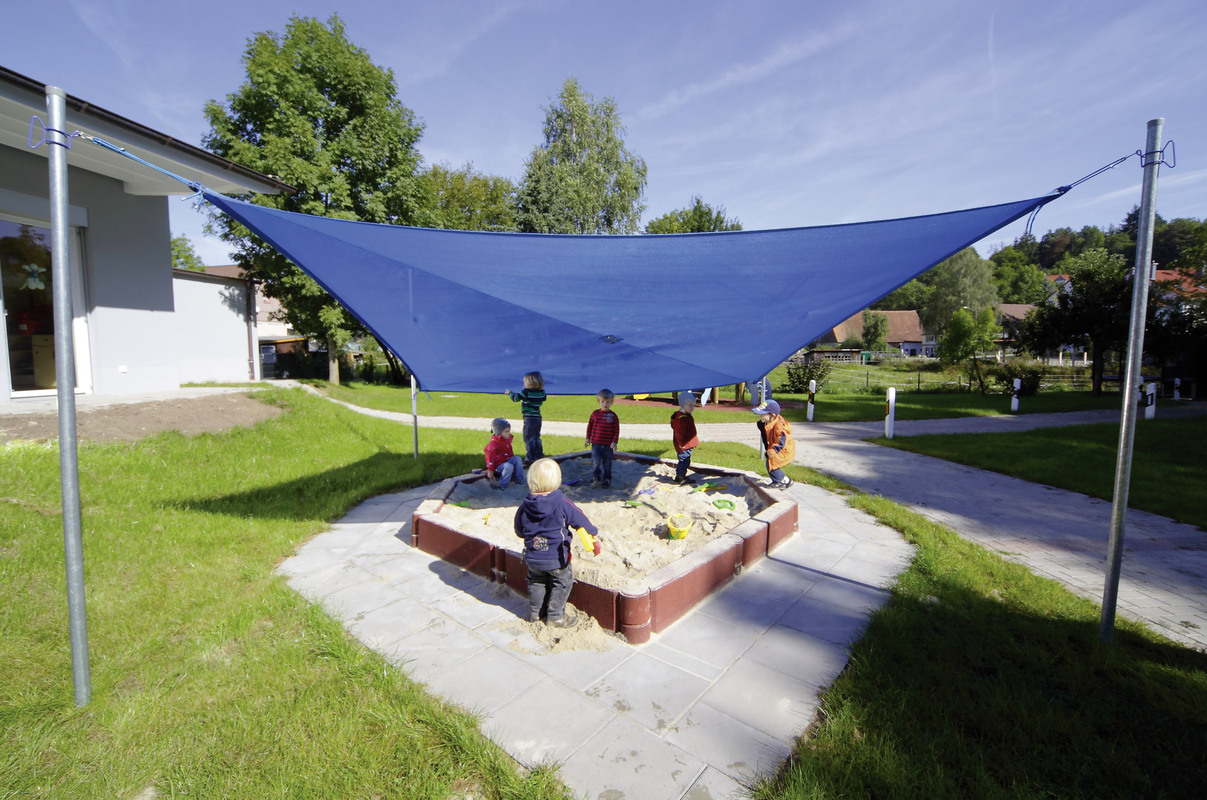When the thermometer shoots up in summer, outdoor play areas should definitely be provided with shade, because children’s skin is extremely sensitive. When digging and building in the sand, for example, children often lose themselves in the game and do not even notice how the sun is affecting them. A sandbox with sun protection is therefore indispensable. A sunshade should not only create cooler temperatures, but above all keep the dangerous UV rays away from your child. However, a shade provider is not automatically a good sunscreen. To protect children’s skin from UV rays, the shade source must therefore have certain features. But what is the difference between a pure shade provider and effective sun protection?
Table of contents
- Children’s skin needs real sun protection
- Not all sun protection is the same
- Sandpit with sun protection – from trees to sun sails
- Conclusion: Sandpit with sun protection
Children’s skin needs real sun protection
Babies and toddlers get sunburn particularly easily. Sun protection is therefore mandatory. The skin’s own UV protection is still developing in children from 0 to 6 years. The pigments that protect us adults against UV rays are produced too slowly by children’s skin to be effective. Damage that has already occurred can only be insufficiently repaired by the skin itself. A severe sunburn at a young age therefore already increases the risk of skin cancer. Educational institutions should therefore make sure that children are generally protected from intense sunlight when playing outdoors – for example, by a sandbox with sunscreen. Because even when the sky is cloudy, the danger is not averted. Up to 80 % of UV rays still make it to the skin. For optimal development, however, children still need to be out in the fresh air: the sun is mainly responsible for the formation of vitamin D.
Not all sun protection is the same
As with clothing, the material of a sunshade for, e.g., a sandbox, is crucial. A light cotton shirt can let through almost as much UV radiation as none at all. That is why there are special fabrics with a sun protection factor that provide more reliable protection – for clothing as well as for sandpit covers or sun sails. However, care must be taken with the terminology: A UV-resistant textile does not automatically have UV protection. The term merely describes the fact that the material can withstand intense sunlight and does not fade or tear, which, by the way, is also an advantage when it occasionally rains in summer. Stretching a fabric high up as a shade does not mean that children playing in the sandpit or garden are protected from dangerous UV radiation – the material of a sunshade also absolutely needs a sun protection factor.
Sandpit with sun protection – from trees to sun sails
Solid materials, such as wood, can protect against UV radiation. For example, in the form of a tree house or a wooden hut in which children can stay and play. Large trees also provide shade – however, size, location and tree canopy density determine how much radiation is shielded. A tree is therefore less suitable as a flexible, reliable shading solution. Sun sails or various covers for the sandbox are the most suitable sun protection for outdoor play areas such as sandboxes and the like. When choosing a sun sail, facility managers and architects should make sure that the material of the sail is UV-resistant and has a very high sun protection factor – our eibe sun sails, for example, have an 86% sun protection factor. Such a sail is stable, durable and protects playing children from dangerous UV radiation at the same time.
Conclusion: Sandpit with sun protection
In the private sphere, parents are responsible for their children and should therefore keep an eye on proper sun protection. Sunscreen and protective clothing are basic and important measures for shielding children from UV rays. In the private garden, sunscreen without a sun protection factor is sometimes sufficient for the sandbox. Within educational institutions, however, external shade providers must be installed to protect children from the sun outdoors. Sun protection with a sun protection factor is therefore extremely important, especially for sandboxes and other open areas without a roof. In principle, however, parents must also be made responsible and sensitised to the issue, especially in summer. Children should always avoid the strong midday sun in the summer months. So it’s better to go indoors at midday and continue playing there!
Read more: Shade is a must in the warm season.
But what options are there? We introduce you to sun protection options for the outdoors.

